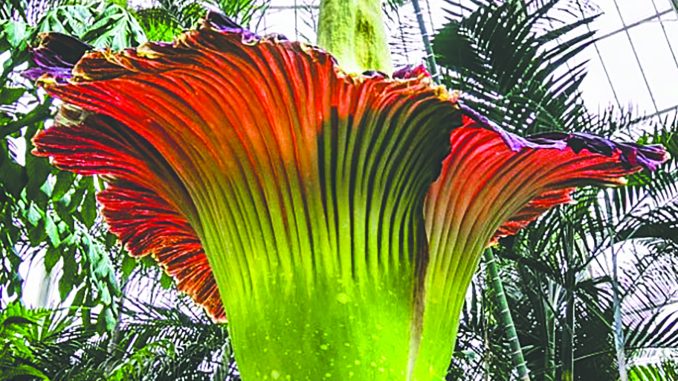
An Amorphophallus titanum, or “corpse flower,” bloomed at The New York Botanical Garden (NYBG) in the Enid A. Haupt Conservatory this past week. The spectacular blooming flower gets its macabre nickname from the distinct odor, which some have described as similar to the smell of rotting meat, during its brief 24- to 36-hour bloom. Its smell serves a purpose, though, attracting pollinators that feed on dead animals. The corpse flower first bloomed in the Western Hemisphere at NYBG in 1937 and 1939, and it took nearly 80 years for another one to bloom. The 2016 plant attracted more than 25,000 visitors to smell the bloom in person and nearly two million views of its progress on a live online video feed.
What is it?
Titan-arum or corpse flower (Amorphophallus titanum) is native to the island of Sumatra in Indonesia. Its enormous flower spike is the largest unbranched inflorescence (flower structure) in the Plant Kingdom. The fleshy central spike, called a spadix, bears small flowers in rings around its base. The spadix can grow up to 12 feet tall. The spadix is wrapped in a frilly, modified leaf called a spathe. When the plant is ready to bloom, the spathe unfurls, exposing the flowers inside. You may recognize the structure’s resemblance to calla-lily, anthurium, and jack-in-the-pulpit, which are all relatives in the arum family, Araceae. Amorphophallus titanum is often called corpse flower because when it blooms, it emits a powerful stench similar to that of rotting meat. This scent, along with the deep-red, meaty color of the open spathe, attracts insect pollinators that feed on dead animals.
What’s happening?
Titan-arums take years to form flower buds, but when they finally do, the flowers mature very quickly. In the beginning of the bloom cycle, a titan-arum grows four to six inches each day.
Later, growth slows significantly. Two leaves at the base of the spathe shrivel and fall off. The spathe begins to open, revealing the red-purple color inside, and completely unfurls over the course of about 36 hours. During full bloom, the spadix self-heats to approximately human body temperature, which helps disseminate odor particles.
How is it cultivated?
This titan-arum has been nurtured in the warm tropical zone of the Nolen Greenhouses. The hot and humid conditions in the greenhouse mimic the natural conditions of Sumatra. The plant must be watered and fertilized copiously.
Why all the excitement?
Titan-arum blooms are rare and unpredictable. Each plant takes seven years or more to store enough energy to bloom for the first time. This titan-arum is 12 years old.
A Long, Stinky History
NYBG received its first titan-arum from Sumatra in 1932. In May 1937, a flower bud appeared. This was the first titan-arum to flower in the Western Hemisphere, and the Conservatory was mobbed with visitors, reporters, and photographers. After a long wait, the plant finally bloomed on June 8. Its eight-foot spadix was the largest ever grown in cultivation.
A second specimen bloomed at NYBG on July 2, 1939. The Bronx Borough President commemorated the event by designating Amorphophallus titanum the official flower of the Bronx. (It was replaced by the more conventionally attractive daylily in 2006.)
—Submitted by the New York Botanical Garden

